2. 中国科学院大学, 北京 100049;
3. 中国科学院青藏高原地球科学卓越创新中心, 北京 100101;
4. 中国地质科学院地质研究所, 北京 100037
2. University of Chinese Academy of Sciences, Beijing 100049, China;
3. CAS Center for Excellence in Tibetan Plateau Earth Sciences, Beijing 100101, China;
4. Institute of Geology, Chinese Academy of Geological Sciences, Beijing 100037, China
北祁连造山带为加里东期造山带(黄汲清等, 1977; 许志琴等, 1994; 张建新等, 1997, 1998; 宋述光, 1997)(图 1a)。新元古代晚期Rodinia超大陆发生裂解,北祁连及其邻区从东冈瓦纳大陆分离出来(葛肖虹和刘俊来, 1999; Song et al., 2013; Xu et al., 2016),北祁连洋盆在寒武纪-奥陶纪进入沟-弧-盆演化阶段,形成蛇绿岩(王荃和刘雪亚, 1976; 肖序常等, 1978; 冯益民和何世平, 1995; 张旗等, 1997, 1998)、高压变质岩(吴汉泉, 1980, 1982; 宋述光等, 2004; Zhang et al., 2007; Song et al., 2009; 喻星星和张建新, 2016; Zhang et al., 2017)以及岛弧岩浆岩(夏林圻等, 1991, 1995; 吴才来等, 2006, 2010; Song et al., 2013; Chen et al., 2014)。北祁连洋盆闭合的时间存在不同认识:有学者认为洋盆于晚奥陶世末-早志留世(ca.450~440Ma)闭合,形成碰撞后花岗岩、志留纪前陆盆地沉积和泥盆纪陆相磨拉石沉积(冯益民和吴汉泉, 1992; 吴才来等, 2010; Song et al., 2013);部分学者认为北祁连早-中志留世浊积岩形成于弧前环境,洋盆于晚志留世才发生闭合(左国朝和刘寄陈, 1987; Yan et al., 2010);也有学者提出北祁连九个泉蓝片岩中蓝闪石、多硅白云母的Ar-Ar年龄(413±5Ma、415±7Ma)代表北祁连洋盆的闭合时间(林宜慧等, 2010)。相应地,对北祁连山北缘规模较大的金佛寺花岗岩体的时代和构造环境也有不同的认识,例如:吴才来等(2010)获得金佛寺岩体的锆石U-Pb年龄为424.1±3.3Ma,并提出其形成于碰撞后环境;而Sun et al. (2013)获得金佛寺岩体的锆石U-Pb年龄为416.7±4.1Ma,认为其代表祁连地块与阿拉善地块碰撞的时间。
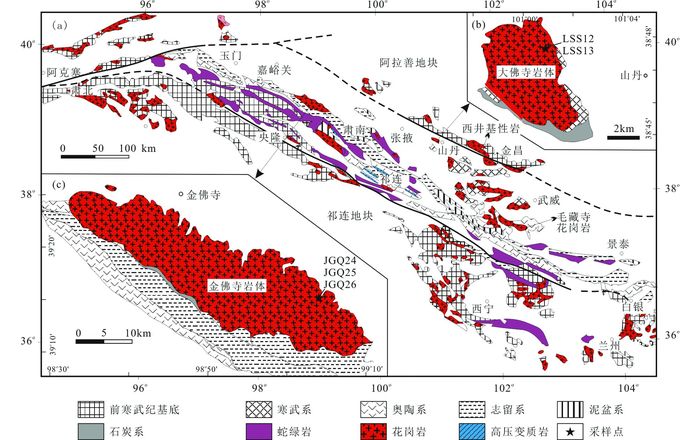
|
图 1 北祁连造山带(a, 据李廷栋等, 2006; Song et al., 2013)以及大佛寺(b, 据甘肃省地质局1971a①)和金佛寺(c, 据甘肃省地质局, 1969②, 1971b③, 1976④)花岗岩体地质简图 Fig. 1 Schematic geological maps of North Qilian Orogen (a, modified after Li et al., 2006; Song et al., 2013), Dafosi (b) and Jinfosi (c) granite plutons |
① 甘肃省地质局. 1971a. 1:20万山丹幅地质图
② 甘肃省地质局. 1969. 1:20万酒泉幅地质矿产图
③ 甘肃省地质局. 1971b. 1:20万肃南幅地质图
④ 甘肃省地质局. 1976. 1:20万祁连山幅地质图
北祁连造山带夹持于中祁连地块、阿拉善地块之间。二十世纪六、七十年代,地质学家在北祁连优地槽与阿拉善地块之间划分出走廊过渡带(又称河西走廊山前坳陷、河西走廊边缘坳陷),二者之间以祁连北缘深断裂为分界(黄汲清等, 1974)。走廊过渡带在地理上与甘肃省河西走廊基本吻合,早期被认为是祁连山地槽带的一部分(李春昱等, 1975),后被认为属于阿拉善地块(冯益民和吴汉泉, 1992; 宋述光, 1997; Zhang et al., 2016)。走廊过渡带缺乏前寒武纪地层,火山岩不发育,在寒武纪-奥陶纪时接受大量源自北方阿拉善地块的陆源碎屑沉积,又有众多的花岗岩体侵入于寒武系砂岩、板岩和灰岩地层之中。诸多花岗岩体的时代、特征及形成环境尚缺乏细致的研究,深部地壳属性亦不明确。
本文报道北祁连造山带北缘金佛寺、走廊过渡带大佛寺两个花岗岩体的锆石U-Pb SIMS定年、锆石Hf-O同位素以及全岩主量和微量元素的分析结果,揭示上述花岗岩体的岩石地球化学特征及其源区的属性;探讨北祁连洋盆可能的闭合时限。
2 地质概况及岩石学特征大佛寺岩体(图 1b)位于甘肃省河西走廊山丹县城以西约5km,向北距离龙首山断裂约6~10km,构造位置隶属走廊过渡带。岩体呈近等轴状,出露面积约30km2,侵入于寒武系大黄山群砂岩、泥质板岩之中,又被石炭系砂岩、页岩及第三系砂砾岩不整合覆盖。岩体为二长花岗岩,造岩矿物包括石英、碱性长石、斜长石和黑云母。碱性长石粒度粗大,主要为条纹长石,其中含石英、黑云母包裹体,副矿物为锆石。本文用于锆石U-Pb定年的样品(LSS12) 采自山丹水库之南大佛寺公园西侧,GPS位置为N38°48′05.4″、E101°00′59.5″,海拔1715m。
金佛寺岩体(图 1c)位于甘肃省酒泉市东南约40km之外的走廊南山北缘,构造位置属北祁连造山带,因邻近金佛寺镇而得名。岩体北西-南东向展布,长约55km,宽10~13km,面积约620km2。岩体南侧主要侵入于志留系中-下统的复理石沉积地层以及北祁连造山带奥陶系阴沟群之中,局部被石炭系下统臭牛沟组灰岩、砂岩夹页岩及第三系砂砾岩不整合覆盖。前人已对金佛寺岩体进行过锆石U-Pb定年和较详细的岩石地球化学研究,提出该岩体的岩石类型包括二长花岗岩、钾长花岗岩和石英闪长岩(吴才来等, 2010; 党金花, 2011; Sun et al., 2013),并获得了424.1±3.3Ma(吴才来等, 2010)、427.7~421.4Ma(Huang et al., 2017)、416.7±4.1Ma(Sun et al., 2013)、345.0±75.0Ma(党金花, 2011)等多个锆石U-Pb年龄。本文的采样地点位于黄草坝村西南约3km处,样品为黑云母二长花岗岩,主要矿物为石英、斜长石、钾长石和黑云母,其中1件样品(JGQ26) 中含有少量(<2%)角闪石。副矿物为锆石、榍石、磷灰石。用于锆石U-Pb定年的样品(JGQ24) 的GPS位置为N39°15′05.9″、E99°03′19.5″,海拔2223m。
3 分析方法本文对河西走廊大佛寺、走廊南山北缘金佛寺岩体的样品进行了锆石U-Pb SIMS定年、Hf-O同位素以及全岩主量、微量元素分析,均在中国科学院地质与地球物理研究所完成,实验方法如下:
主量元素测试使用荷兰PANalytical公司AXIOS Minerals X射线荧光光谱仪。样品粉末在105℃烘干,称取0.5g测定烧失量;使用无水Li2B4O7为助熔剂,NH4Br为发泡剂,在M4自动熔样机中制成玻璃片。采用国家一级岩石标样GBW07101-07114。
微量元素分析采用Finnigan Element型电感耦合等离子体质谱仪(ICP-MS)。称取40mg样品粉末放在Teflon溶样罐中,依次加入HF和HNO3后置于烘箱中在~200℃加热使样品全溶;使用1.0ML 500×10-9的In为内标。标样使用GSR-1和GSR-3,测试精度优于10%。
锆石氧同位素分析、U-Pb定年使用Cameca IMS-1280型二次离子质谱仪(SIMS)。单矿物分选由河北省廊坊区域地质矿产调查院完成,使用破碎、重选、磁选、双目镜下手工挑选等常规流程。将锆石样品与标样Plésovice、Qinghu、Penglai粘贴于环氧树脂靶上,打磨抛光使其暴露出一半晶面。结合透射光、反射光和阴极发光图像选择测试点位。氧同位素分析方法如下:用强度~2nA的一次Cs+离子束在10kV加速电压下轰击样品表面,束斑直径~15μm,二次负离子提取的加速电压为-10kV,使用30eV能量窗过滤,质量分辨率2500,用两个法拉第杯同时接收16O和18O。单组18O/16O数据精度一般优于0.2‰~0.3‰(1σ),仪器质量分馏用标样Penglai (δ18O=5.31±0.10‰, Li et al., 2010)校正,所测18O/16O用V-SMOW值(18O/16O=0.0020052) 校正,加上仪器质量分馏校正因子IMF,得到样品点的δ18O值:(δ18O)M=((18O/16O)M/0.0020052-1)×1000(‰),IMF=(δ18O)M(标样)-(δ18O)实际值,δ18O样品=(δ18O)M-IMF。详细分析方法见李献华等(2009)和Li et al. (2010)。
锆石U-Pb定年点位与氧同位素分析的相同。一次O2-离子束强度10nA,加速电压-13kV,束斑大小20μm×30μm;二次离子束用60eV的能量窗过滤;质量分辨率为7000,采用单接收系统以跳峰方式循环测量所需信号。样品与标样Plésovice (337.13±0.37Ma, Sláma et al., 2008)、Qinghu(159.5±0.2Ma, Li et al., 2009, 2013)按比例交替测试,以Qinghu作为未知样监测数据的精确度。样品的U、Pb含量和Pb/U比值用标样Plésovice进行校正,普通Pb用测量的204Pb校正,假定普通Pb主要源于样品表面的污染,普通Pb组成使用现代地壳的平均Pb同位素组成(Stacey and Kramers, 1975)。数据处理采用Isoplot(v.3.0) 软件(Ludwig, 2009),详细的分析流程见Li et al.(2009, 2013)、李献华等(2009)和杨亚楠等(2014)。
锆石Hf同位素分析使用德国Finnigan Mat公司Neptune多接收电感耦合等离子体质谱仪(MC-ICP-MS)及德国Lamda Physik公司的193nm准分子激光发生器。Neptune MC-ICP-MS上配有9个法拉第杯和1个离子计数器。激光波长193nm,脉冲宽度为15ns,最大实际输出功率35J/cm2,束斑直径60μm。Hf同位素分析与氧同位素、U-Pb定年分析的束斑中心位置基本一致。详细的分析方法见徐平等(2004)和Wu et al. (2006)。分析过程中标样MUD Tank的176Hf/177Hf值为0.282487±0.000010 (2σ,n=15)(标准值0.282504±0.000044, Woodhead and Hergt, 2005),标样PengLai的176Hf/177Hf值为0.282908±0.000018 (2σ,n=10)(标准值0.282906±0.000010, Li et al., 2010)。
4 分析结果 4.1 锆石U-Pb年龄大佛寺岩体(LSS12)、金佛寺岩体(JGQ24) 的锆石U-Pb SIMS定年结果见表 1。大佛寺花岗岩的锆石呈板柱状,粒径在50~200μm之间,长宽比1:1~3:1,在阴极发光图像上显示明显的同心生长环带(图 2a),锆石U、Th含量分别为97×10-6~619×10-6和63×10-6~513×10-6,Th/U介于0.45~1.02之间。金佛寺花岗岩的锆石为细长柱状,粒径30~300μm之间,长宽比例在2:1~6:1之间,在阴极发光图像上显示明显的同心生长环带(图 2b),锆石U、Th含量分别为246×10-6~1151×10-6和100×10-6~942×10-6,Th/U介于0.17~0.88之间。所测锆石的结构特征和Th/U比值均符合典型岩浆锆石的特征(Corfu et al., 2003; Hoskin and Schaltegger, 2003)。大佛寺岩体19粒锆石给出的谐和年龄为426.1±2.8Ma(图 3a),金佛寺岩体14粒锆石给出的谐和年龄为424.0±1.6Ma(图 3b)。
|
|
表 1 甘肃大佛寺、金佛寺花岗岩的锆石U-Pb SIMS分析结果 Table 1 Zircon U-Pb SIMS analyses for the Dafosi and Jinfosi granite plutons, Gansu Province |
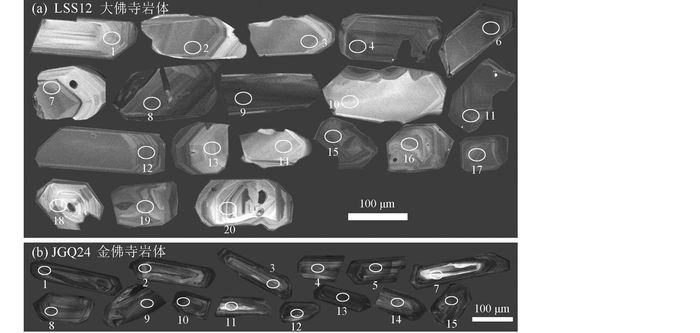
|
图 2 大佛寺、金佛寺花岗岩体的锆石阴极发光图像 椭圆代表U-Pb定年位置和束斑大小(20μm×30μm),Hf-O同位素分析与U-Pb定年的束斑中心基本相同,编号与表 1一致 Fig. 2 Cathodoluminescence (CL) images for zircons from the Dafosi (a) and Jinfosi (b) granite pluton The ellipses show the positions and spot size (20μm×30μm) for U-Pb dating. Spot centers for Hf-O isotope analysis are the same as that for U-Pb dating |
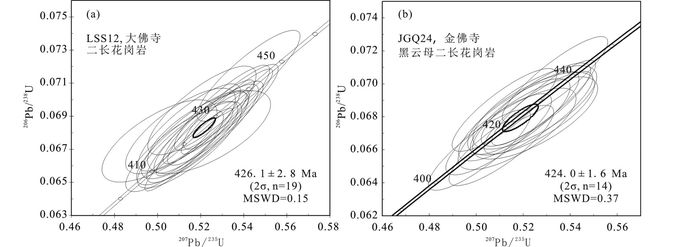
|
图 3 大佛寺、金佛寺花岗岩锆石U-Pb年龄谐和图 Fig. 3 U-Pb concordia diagrams for the Dafosi (a) and Jinfosi (b) granites |
大佛寺、金佛寺岩体的锆石Hf-O同位素分析结果见表 2和图 4。
|
|
表 2 甘肃大佛寺、金佛寺花岗岩中锆石Hf、O同位素分析结果 Table 2 Hf and O isotopes of the Dafosi and Jinfosi granite plutons, Gansu Province |
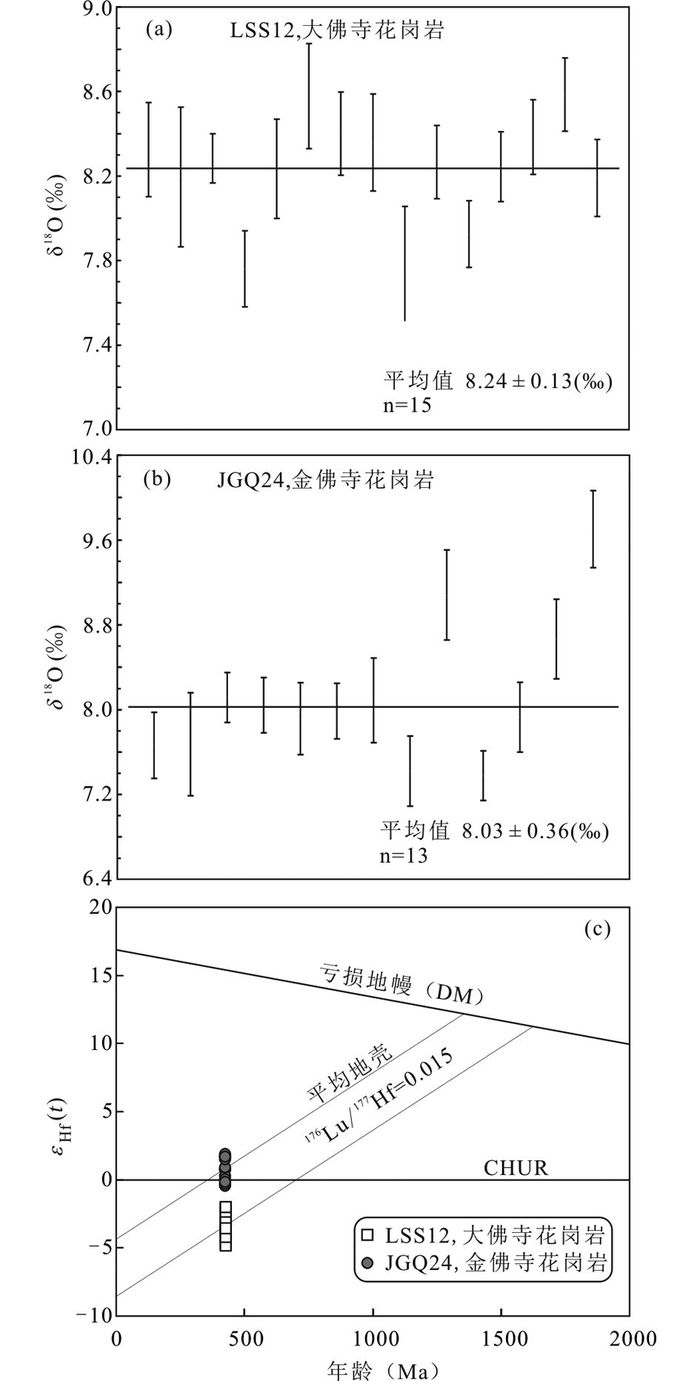
|
图 4 大佛寺(LSS12)、金佛寺(JGQ24) 花岗岩锆石的Hf-O同位素特征 平均地壳176Lu/177Hf=0.015 (Griffin et al., 2002),图 4c中平均地壳演化线分别穿过LSS12和JGQ24的εHf(t)平均值(-3.4和+0.9).亏损地幔(DM)176Hf/177Hf=0.28325,176Lu/177Hf=0.0384(Griffin et al., 2000),具体数据及计算见表 2 Fig. 4 Hf-O isotopes of zircons from the Dafosi (LSS12) and Jinfosi (JGQ24) granites The average continental crust has 176Lu/177Hf=0.015 (Griffin et al., 2002), and has evolution lines passing through the average εHf(t) of LSS12 (-3.4) and JGQ24 (+0.9), respectively. 176Hf/177Hf and 176Lu/177Hf of the depleted mantle (DM) are 0.28325 and 0.0384, respectively (Griffin et al., 2000). Detailed analyses and calculations are presented in Table 2 |
大佛寺花岗岩(LSS12)15粒锆石的176Hf/177Hf比值为0.282375~0.282456,加权平均值为0.282417±0.000014 (2σ,MSWD=1.4)。样品的εHf(0) 在-14.0~-11.2之间,εHf(t)为-4.8~-2(t=426.1Ma),Hf同位素单阶段(tDM)、两阶段(tDMC)亏损地幔模式年龄分别为1118~1224Ma和1540~1717Ma。
金佛寺花岗岩(JGQ24)13粒锆石的176Hf/177Hf比值为0.282508~0.282571,加权平均值为0.282540±0.000014 (2σ,MSWD=2.2)。样品的εHf(0) 在-9.3~-7.1之间,εHf(t)为-0.5~+1.9(t=424.0Ma),Hf同位素单阶段、两阶段亏损地幔模式年龄分别为968~1070Ma和1289~1439Ma。
大佛寺花岗岩15粒锆石的δ18O变化范围为7.8‰~8.6‰,平均8.24±0.13‰(图 4a)。金佛寺花岗岩13粒锆石的δ18O变化范围为7.4‰~9.7‰,平均值为8.03±0.36‰(图 4b)。根据全岩-锆石在岩浆温度下氧同位素分馏的经验公式(Valley et al., 2005):δ18O(全岩)=δ18O (锆石)+0.0612(wt% SiO2)-2.5,得到大佛寺、金佛寺花岗岩的全岩δ18O平均值分别为10.4±0.3‰和9.7±0.7‰。
4.3 主量、微量元素大佛寺(LSS12、LSS13)、金佛寺(JGQ24、JGQ25、JGQ26) 岩体的主量和微量元素分析结果见表 3。大佛寺花岗岩为高钾钙碱性、弱过铝质(A/CNK=1.03~1.06)(图 5),SiO2(76.7%~78.9%)、Na2O+K2O(7.7%~8.3%)含量及FeOT/MgO(6.3%~7.6%)、(Na2O+K2O)/CaO(14.8~17.1) 比值较高,MgO(~0.1%)、CaO(0.5%~0.6%)、TiO2(<0.1%)、P2O5(~0.01%)含量低,K2O/Na2O比值为1.1~1.4。微量元素方面,大佛寺花岗岩具有较高的Rb(303×10-6~383×10-6)、Nb(32×10-6~42×10-6)、重稀土(Yb ~8×10-6)含量及Ga/Al(>3×10-4)、Rb/Ba(3.0~6.2) 比值,较低的Ba(49×10-6~130×10-6)和Sr(18×10-6~36×10-6)含量。在微量元素原始地幔标准化蛛网图中,Ba、Sr、Eu(Eu/Eu*=0.04~0.09)、Ti强烈亏损(图 6a),在球粒陨石标准化图,稀土元素呈“海鸥”型分布(图 6b)。
|
|
表 3 甘肃大佛寺、金佛寺花岗岩的主量(wt%)和微量(×10-6)元素分析结果 Table 3 Major (wt%) and trace (×10-6) elements of the Dafosi and Jinfosi granites, Gansu Province |
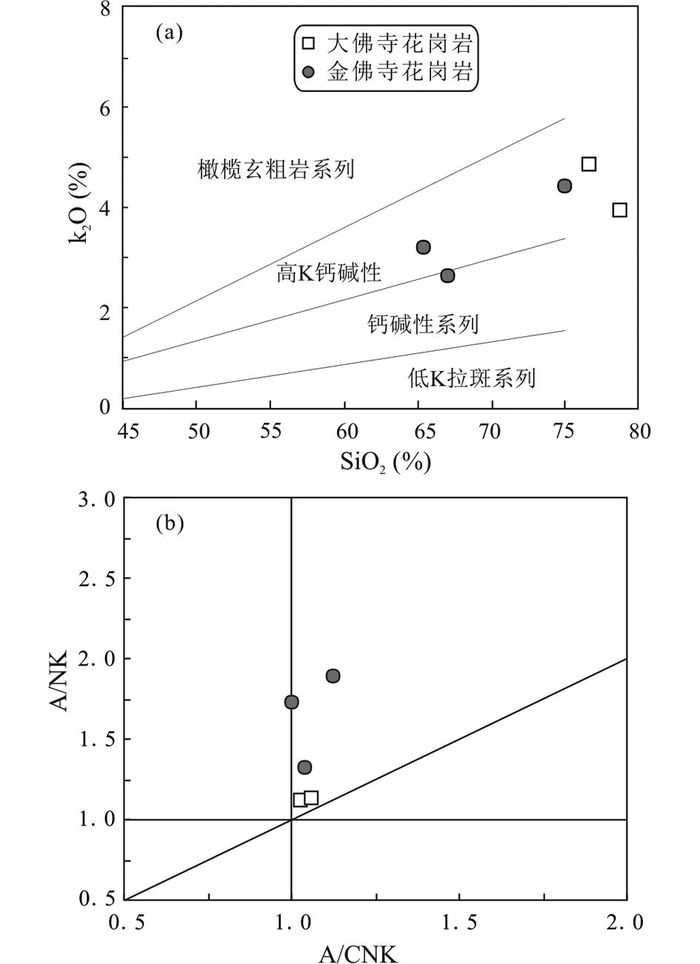
|
图 5 大佛寺、金佛寺花岗岩的SiO2-K2O (a)和A/CNK-A/NK (b)图解 Fig. 5 SiO2 vs. K2O (a) and A/CNK-A/NK (b) diagrams for the Dafosi and Jinfosi granites |
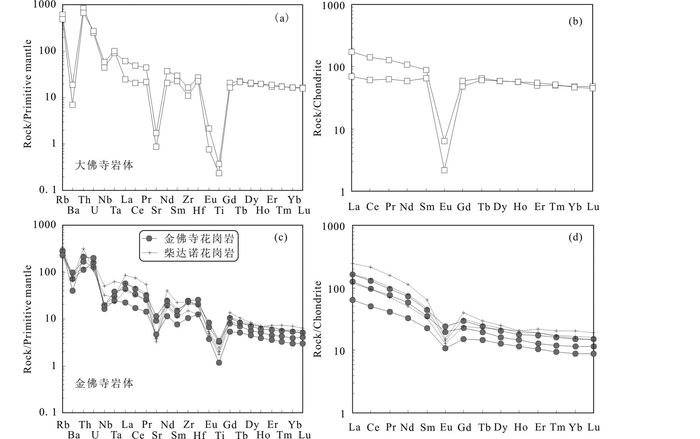
|
图 6 大佛寺(a、b)和金佛寺(c、d)花岗岩的原始地幔标准化微量元素蛛网图和球粒陨石标准化稀土元素分布图(标准化值据Sun and Mcdonough, 1989) 金佛寺与柴达诺花岗岩(Chen et al., 2014)具有相似的微量元素特征 Fig. 6 Primitive mantle-normalized spidergrams and chondrite-normalized REE distributions for the Dafosi (a, b) and Jinfosi (c, d) granites (normalization data from Sun and Mcdonough, 1989) Trace elements of the Dafosi and Chaidanuo (Chen et al., 2014) granites are similar |
金佛寺花岗岩为高钾钙碱性(图 5a),SiO2(65.5%~75.0%)、MgO(0.6%~2.2%)、Fe2O3(1.9%~5.2%)、CaO(1.5%~3.5%)和TiO2(0.3%~0.8%)变化较大,Na2O+K2O含量、K2O/Na2O比值分别为5.8%~7.4%和0.8~1.5,在A/CNK-A/NK图解中(图 5b),显示过铝质特征(A/CNK=1.0~1.1)。结合前人的数据资料(吴才来等, 2010; Sun et al., 2013),岩体的P2O5含量随着SiO2的增加而逐渐减少。在微量元素和稀土元素分布图中,金佛寺花岗岩具有较明显的Ba、Sr、Eu、Nb、Ta和Ti的负异常,轻重稀土元素分馏较强,微量元素特征与柴达诺花岗岩(Chen et al., 2014)相似(图 6c, d)。
5 讨论 5.1 大佛寺、金佛寺岩体的类型及成因 5.1.1 大佛寺花岗岩大佛寺花岗岩具有较高的SiO2、Na2O+K2O、Rb、Nb、HREE(重稀土)含量及FeOT/MgO、Ga/Al、Rb/Ba比值,MgO(~0.1%)、CaO(0.5%~0.6%)、TiO2(<0.1%)、P2O5(~0.01%)含量低,强烈亏损Ba、Sr、Ti,Eu负异常显著,与典型A型花岗岩的地球化学特征一致(Whalen et al., 1987; Wu et al., 2002)。在Ga/Al相对于(Na2O+K2O)/CaO、FeOT/MgO、Nb、Y的图解中,大佛寺花岗岩落入A型花岗岩的范围(图 7)。
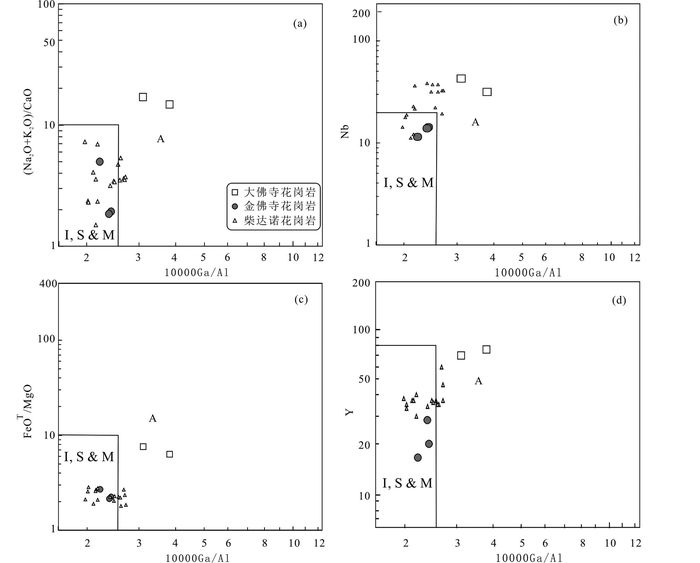
|
图 7 大佛寺、金佛寺花岗岩的10000Ga/Al相对于(Na2O+K2O)/CaO (a)、Nb (b)、FeOT/MgO (c)和Y (d)的判别图(据Whalen et al., 1987) Fig. 7 10000Ga/Al vs. (Na2O+K2O)/CaO (a), Nb (b), FeOT/MgO (c), and Y (d) plots for the Dafosi and Jinfosi granites (after Whalen et al., 1987) |
A型花岗岩最初定义为碱性(alkaline)、贫水(anhydrous)、非造山(anorogenic)的花岗岩(Loiselle and Wones, 1979),并不指示特定的源区和形成方式(Clemens et al., 1986),可能的成因有:(1) 经历部分熔融的下地壳麻粒岩残留再次熔融(Clemens et al., 1986; Whalen, 1987);(2) 英云闪长岩和花岗闪长岩部分熔融(Creaser et al., 1991; Patiño Douce, 1997);(3) 受交代的岩石圈地幔发生熔融(Whalen et al., 1996);(4) 麻粒岩相的变质泥质岩部分熔融(Huang et al., 2011);(5) 幔源岩浆结晶分异(Steinitz et al., 2009)。Eby (1992)据Y/Nb、Rb/Nb比值等将A型花岗岩划分为A1和A2两个亚类,A1型主要为大陆裂谷环境中类似洋岛玄武的岩浆分异形成,A2型为岛弧玄武岩或陆-陆碰撞环境的陆壳物质重熔形成;大佛寺花岗岩的Y/Nb和Rb/Nb值分别为1.6~2.4和7~12,按Eby (1992)的分类方式属A2型。Patiño Douce (1999)系统总结了不同种类岩石(角闪岩、杂砂岩、泥质岩和花岗岩)脱水熔融所产生的中酸性熔体的主量元素特征,Sylvester (1998)总结了碰撞后环境强过铝质花岗岩(A/CNK>1.1) 的地球化学特征,大佛寺花岗岩的主量元素指示其源区很可能为长英质的泥质岩石(图 8a-c),微量元素特征(如Rb/Sr、Rb/Ba)与泥质岩熔融形成的熔体成分接近(图 8d),与根据主量元素得出的判断相符。经历部分熔融的下地壳麻粒岩残留应该是贫Rb、Na和K的,并且含水量很低,英云闪长岩和花岗闪长岩中含水量也很低,因此由这些岩石部分熔融形成有较大规模的A型花岗岩似乎比较困难;岩石圈地幔熔融形成的岩浆应该是基性或中性为主,具有较高的Ba、Sr及Mg、Cr、Ni含量,例如sanukitoid(Tatsumi and Ishizaka, 1981; Stern et al., 1989)和一些富碱的中基性岩脉(Yang et al., 2004),不大可能是A型花岗岩。
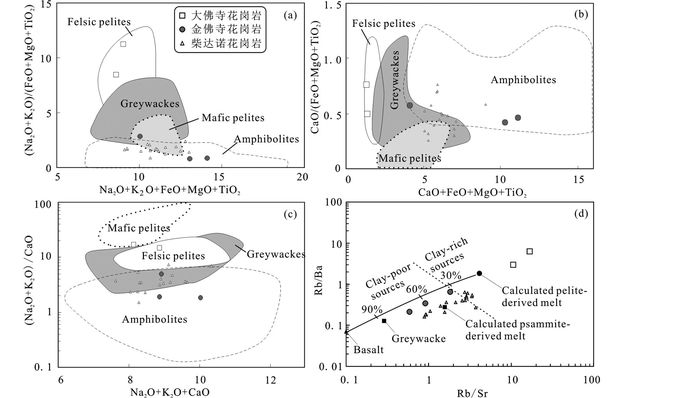
|
图 8 大佛寺、金佛寺花岗岩的(Na2O+K2O)/(FeO+MgO+TiO2)-(Na2O+K2O+FeO+MgO+TiO2) (a)、CaO/(FeO+MgO+TiO2)-(CaO+FeO+MgO+TiO2) (b)、(Na2O+K2O)/CaO-(Na2O+K2O+CaO) (c) (a-c, 据Patiño Douce, 1999)和Rb/Ba-Rb/Sr (d, 据Sylvester, 1998)源岩判别图解 Fig. 8 (Na2O+K2O)/(FeO+MgO+TiO2) vs. (Na2O+K2O+FeO+MgO+TiO2) (a), CaO/(FeO+MgO+TiO2) vs. (CaO+FeO+MgO+TiO2) (b), (Na2O+K2O)/CaO vs. (Na2O+K2O+CaO) (c) (a-c, after Patiño Douce, 1999), and Rb/Ba vs. Rb/Sr (d, after Sylvester, 1998) diagrams indicating possible sources for the Dafosi and Jinfosi granites |
大佛寺花岗岩中未见继承锆石。使用Watson and Harrison (1983)的Zr饱和温度与熔体成分关系的经验公式,计算得到岩浆的Zr饱和温度为816~850℃(表 3),表明岩浆温度达到~820℃以上,与A型花岗岩岩浆通常温度较高(Clemens et al., 1986; Patiño Douce, 1997)的特征吻合;Ti饱和温度(Hayden and Watson, 2007)为679~715℃,显著低于Zr饱和温度,可能是Ti不饱和所致。大佛寺花岗岩的HREE含量较高且呈平坦型,具有强烈的Eu和Sr负异常,表明部分熔融残留中斜长石稳定存在而石榴石缺失;锆石的εHf(t)在-4.8~-2.0之间(表 2),Hf同位素两阶段亏损地幔模式年龄1540~1717Ma,远大于岩体的形成年龄,表明源区主要为古老陆壳物质。
大佛寺花岗岩的锆石δ18O为7.8‰~8.6‰,显著高于与幔源岩浆平衡的锆石δ18O值(5.3±0.3‰, Valley et al., 2005);对应的大佛寺花岗岩的全岩δ18O为10.0‰~10.8‰,与上地壳平均δ18O值(9.7±1.3‰, Simon and Lécuyer, 2005)及加拿大Superior省变质的不成熟碎屑沉积岩的δ18O值相近(Longstaffe and Schwarcz, 1977),也在变质泥质岩的δ18O范围之中(8‰~14‰, Simon and Lécuyer, 2005),但低于较成熟的沉积岩的全岩δ18O值(Longstaffe and Schwarcz, 1977; Valley et al., 2005)。我国华南中生代一些含铁橄榄石A型花岗岩具有相似的锆石δ18O和εHf(t)值(分别为8.0‰~9.8‰和-6.2~-2.3),其源岩可能为麻粒岩相的变质沉积岩(Huang et al., 2011)。δ18O值较低的A型花岗岩也有报道,例如以色列南部Timna碱性花岗岩的锆石δ18O值为5.5‰,可能由幔源岩浆结晶分异形成(Steinitz et al., 2009)。大佛寺花岗岩的锆石氧同位素特征指示有上地壳物质的加入,并未显示幔源岩浆加入的信息。大佛寺花岗岩侵入于寒武系大黄山群砂岩、泥质板岩之中(图 1),大黄山群的碎屑锆石年龄介于0.5~3.6Ga,最大峰值在~1.0Ga左右(Zhang et al., 2016);大佛寺花岗岩是否由类似于大黄山群沉积物熔融形成,值得进一步研究。
值得注意的是,一些高分异的I和S型花岗岩可具有较高的Ga/Al比值(Whalen, 1987),其地球化学特征与A型花岗岩有相似之处(Whalen, 1987; Chappell and White, 1992);长石的持续分离可导致熔体中Rb含量的升高和Ba、Sr含量的降低(Chappell and White, 1992),熔体的Rb/Sr、Rb/Ba比值有可能因此升高,类似于图 8d中由泥质岩熔融产生的熔体。也有学者认为,A型花岗岩高温的特征指示它可作为一种独立成因类型存在,不可能是I型花岗岩分异而来(吴福元等, 2007)。为了探讨大佛寺花岗岩是否有可能由其它类型花岗岩经过高分异形成,本文进行了简单的模拟计算(表 4、图 9):从成分与JGQ26相同的初始熔浆中分离出68%的斜长石、34%斜长石+34%钾长石、或68%钾长石,残余熔浆Sm、Eu、Gd的含量及Eu/Eu*值均与大佛寺A型花岗岩的特征相似;然而Rb、Sr、Ba的模拟结果并不理想:若68%斜长石分离,残余熔浆的Rb、Sr、Rb/Sr虽与大佛寺A型花岗岩相似,但Ba含量为大佛寺花岗岩的4~10倍;若34%斜长石+34%钾长石或者68%钾长石分离,残余熔浆的Rb、Rb/Sr、Rb/Ba均与大佛寺A型花岗岩大不相同(表 4)。由于斜长石/酸性熔浆之间Ba的分配系数较低(≤1~2),而钾长石/酸性熔浆之间Ba的分配系数大于1(Rollinson, 1993),单纯斜长石的分离结晶不能导致残余岩浆中形成巨大的Ba的负异常,而大量钾长石的分离又会导致Rb和K含量的降低。总之,与JGQ26成分相似的初始熔浆经历高分异演化,难以形成大佛寺A型花岗岩。受制于岩浆的粘度,有较大体积的A型花岗岩体似乎难以由I型或S型花岗质岩浆经历高分异而产生,并且一些花岗质岩浆高度分异的晚期残余熔浆往往具有独特的地球化学特征,如稀土元素因流体作用、副矿物结晶而形成“四分组”效应(tetrad effect)(McLennan, 1994; Bau, 1996; Zhao et al., 2002; Duc-Tin and Keppler, 2015);大佛寺花岗岩的稀土元素缺乏“四分组”效应的特征(图 6b),野外工作中也未发现由长石构成的堆晶岩。
|
|
表 4 花岗质熔体(样品JGQ26) 发生高分异的简单模拟计算 Table 4 Simple modeling showing the geochemistry of highly fractionated melts from a granitic magma represented by Sample JGQ26 |
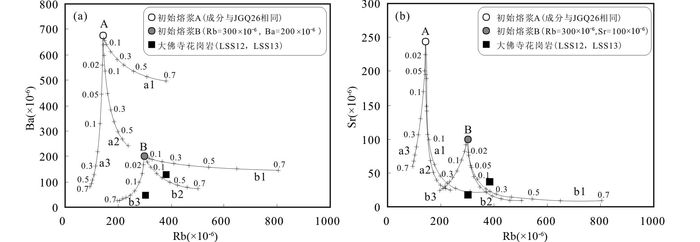
|
图 9 Rb-Ba (a)和Rb-Sr (b)图解 曲线a1-a3和b1-b3分别显示由初始熔浆A(成分与JGQ26相同)、初始熔浆B(Rb=300×10-6,Ba =200×10-6,Sr=100×10-6)经历分离结晶之后残余岩浆的成分.结晶分离的矿物组成分别为:斜长石100%(a1、b1)、钾长石100%(a2、b2)、斜长石80%+钾长石20%(a3、b3).十字符号表示分离矿物占初始熔浆的比例(依次为0.02、0.05、0.1、0.2、0.3、0.4、0.5、0.6、0.7).分配系数根据Nash and Crecraft (1985) Fig. 9 Rb vs. Ba (a) and Rb vs. Sr (b) diagrams showing the modeling results for the possibility of forming A-type granites through fractional crystallization Curves a1 to a3 and b1 to b3 show the residual melts formed by fractional crystallization from initial magmas A (represented by JGQ26) and B (Rb=300×10-6, Ba=200×10-6, and Sr=100×10-6), respectively. The fractionated mineral assemblages are: 100% plagioclase (a1, b1), 100% K-feldspar (a2, b2), and 80% plagioclase + 20% K-feldspar (a3, b3). Crosses indicate the fraction of separated minerals (in the order of 0.02, 0.05, 0.1, 0.2, 0.3, 0.4, 0.5, 0.6, and 0.7). Partition coefficients are after Nash and Crecraft (1985) |
为了探讨大佛寺A型花岗岩是否可能由其它成分的初始熔浆经历结晶分离形成,我们又对图 9中假想的初始熔浆B(Rb=300×10-6,Ba=200×10-6,Sr=100×10-6)的演化进行了模拟计算,结果表明:初始熔浆B经历20%~30%长石矿物的分离结晶,残余熔浆的Rb、Sr、Ba有可能与大佛寺A型花岗岩相近(图 9);然而,20%~30%长石矿物的分离结晶并不足以导致类似于大佛寺样品的Eu的负异常和其它稀土元素的丰度。也就是说,假如与大佛寺岩体成分相似的A型花岗岩是由某个初始熔浆经历分离结晶演化形成,那么对该初始熔浆的成分有一定的要求:其微量元素特征与大佛寺花岗岩应该大体相似,而非迥异。是否其它地区的A型花岗岩具有类似的初始岩浆、结晶分离产物?有待于继续研究。当然,本文模拟计算的不足之处是没有考虑副矿物结晶的效应,并且所采用的分配系数的值也未必适当。
通过上述探讨,我们认为大佛寺A型花岗岩不大可能由其它I型或S型花岗质岩浆通过高分异形成。
5.1.2 金佛寺花岗岩前人认为金佛寺花岗岩属S型(党金花, 2011; Sun et al., 2013),具有少量幔源物质加入(吴才来等, 2010; Sun et al., 2013)。S型花岗岩中一般不含角闪石(Chappell and White, 2001),本文1件样品(JGQ26) 中含少量(<2%)角闪石;S型花岗岩具有较高的87Sr/86Sr初始比值,金佛寺岩体的87Sr/86Sr初始比值为0.705~0.709(吴才来等, 2010; Sun et al., 2013; Huang et al., 2017);S型花岗岩具有较高的K2O/Na2O和FeOT/CaO比值(Chappell and White, 2001),金佛寺花岗岩为弱过铝质(A/CNK=1.0~1.1),K2O-Na2O和FeOT-CaO值介于I型和S型范围之间(Chappell and White, 2001);另外,根据本文及前人的数据(吴才来等, 2010; Sun et al., 2013),金佛寺岩体的P2O5含量随着SiO2的增加而逐渐减少,需要指出的是,虽然一般认为“P2O5含量随着SiO2的增加而减少”是典型I型花岗岩的特征(Chappell and White, 1992; Chappell, 1999),但也不尽然,例如:欧洲喀尔巴阡山海西期的I型、S型、A型均具有“P2O5含量随着SiO2的增加而减少”的特征,只有一些高分异(SiO2>70%)的S型花岗岩才具有P2O5含量随着SiO2的增加而增加的特征(Broska et al., 2004),高分异的S型花岗岩也可以具有很低的P2O5含量(Chappell, 1999; Broska et al., 2004)。综上所述,依据地球化学特征尚难以确定金佛寺岩体属于I型还是S型。
本文金佛寺花岗岩样品的TiO2(0.3%~0.8%)、MgO(0.6%~2.2%)和Fe2O3(1.9%~5.2%)含量变化较大且都与SiO2呈负相关,与黑云母含量的多少有关。值得注意的是,金佛寺花岗岩与北祁连造山带柴达诺花岗岩(505~516Ma)的主量、微量元素特征较为相似(图 6、图 7、图 8);柴达诺花岗岩主体为强过铝质,Sr同位素初始比值很高,在0.737~0.747之间(吴才来等, 2010; Chen et al., 2014),应属S型花岗岩。吴才来等(2010)认为其源岩含有古元古代变质沉积岩;Chen et al. (2014)认为其源岩主要为~750Ma的S型花岗岩和少许贫粘土沉积岩,有少量幔源物质加入。图 8显示柴达诺花岗岩的源岩有可能为杂砂岩,而金佛寺花岗岩的源区包括杂砂岩、角闪岩。金佛寺花岗岩中含有角闪岩包体以及450~500Ma和1.0Ga的继承锆石(Huang et al., 2017),本文获得的岩浆锆石的εHf(t)在-0.5~+1.9之间,锆石δ18O为7.4‰~9.7‰,指示全岩δ18O为9.0‰~11.3‰,指示上地壳物质的加入。如前所述,金佛寺花岗岩的全岩δ18O值显著高于幔源岩浆的δ18O值(Valley et al., 2005),与上地壳平均δ18O值(9.7±1.3‰, Simon and Lécuyer, 2005)及加拿大Superior省变质不成熟碎屑沉积岩的δ18O值(Longstaffe and Schwarcz, 1977)相近,在砂岩的δ18O范围之内(11.0±2.0‰, Simon and Lécuyer, 2005),但低于多数沉积岩的δ18O值(Magaritz and Taylor, 1976; Simon and Lécuyer, 2005; Valley et al., 2005)。综合上述资料,我们推测金佛寺花岗岩的源岩为杂砂岩和角闪岩,可能包括了来自古老地壳和北祁连造山带新生地壳不同来源的成分。
金佛寺花岗岩岩浆的Zr饱和温度(Watson and Harrison, 1983)为806~888℃,Ti饱和温度(Hayden and Watson, 2007)为809~907℃,两种方法估算的结果相近(表 3),表明岩浆温度至少达到800~900℃。
根据已有的全岩Sm-Nd同位素数据(吴才来等, 2010; Huang et al., 2017),计算得到金佛寺花岗岩的全岩Nd同位素亏损地幔模式年龄为1.2~1.9Ga,与本文锆石Hf同位素两阶段亏损地幔模式年龄(1.3~1.4Ga,表 2)吻合,代表其源岩的地壳存留年龄(crustal residence age, Miller et al., 1986; Arndt and Goldstein, 1987)。一般来说,古元古代之后的沉积岩的地层年龄显著小于其地壳存留年龄(Goldstein et al., 1984; Miller et al., 1986),因此大佛寺、金佛寺岩体源岩的沉积时代有可能为新元古代或早古生代早期。
5.2 地质意义北祁连造山带蛇绿岩的形成时代主要集中于520~490Ma之间,个别为~450Ma(相振群等, 2007; 曾建元等, 2007; 孟繁聪等, 2010; 武鹏等, 2012; Xia et al., 2012; 夏小洪等, 2012; Song et al., 2013),榴辉岩变质年龄主要集中于495~490Ma和~460Ma(宋述光等, 2004; Zhang et al., 2007, 2017; Zhang et al., 2015; 喻星星和张建新, 2016),清水沟蓝片岩的变质年龄为466.3~462.2Ma (Cheng et al., 2016),均记录了早寒武世-晚奥陶世期间北祁连洋盆的俯冲演化过程。但是,北祁连洋盆闭合、祁连地块与阿拉善地块碰撞的时间存在晚奥陶世末-早志留世(约445~440Ma:吴才来等, 2010; Song et al., 2013)、晚志留世(左国超等, 1987; Yan et al., 2010)、志留世末-早泥盆世早期(约417~413Ma:林宜慧等, 2010; Sun et al., 2013)等不同的观点。对北祁连造山带北缘规模较大的金佛寺岩体的锆石U-Pb定年存在424.1±3.3Ma(吴才来等, 2010)、345±75Ma(党金花, 2011)、416.7±4.1Ma(Sun et al., 2013)和427.7~421.4Ma(Huang et al., 2017)等差异;金佛寺岩体的形成环境存在碰撞后伸展(吴才来等, 2010; 党金花, 2011)、同碰撞(Sun et al., 2013)等不同的认识。本文测定金佛寺花岗岩的锆石U-Pb年龄为424.0±1.6Ma,与吴才来等(2010)和Huang et al. (2017)的结果一致。
花岗岩的成分和成因与所处的构造环境紧密相关(Pearce et al., 1984; Maniar and Piccoli, 1989; Pearce, 1996; Sylvester, 1998)。通常认为,A型花岗岩形成于非造山或碰撞后板内拉张环境(Loiselle and Wones, 1979; Pearce et al., 1984; Clemens et al., 1986; Creaser et al., 1991; Bonin, 2007; 张旗等, 2012)。在图 10中,大佛寺A型花岗岩和金佛寺花岗岩分别落入板内、火山弧环境。然而,花岗岩的岩石地球化学特征受制于源岩成分、形成的物理化学条件和结晶分异演化过程等多重因素(Chappell and White, 1974, 1992, 2001; Clemens et al., 1986; Patiño Douce, 1999),例如:A型花岗岩可形成于不同构造环境(Whalen et al., 1987; Eby, 1992; King et al., 1997),高分异的I型和S型花岗岩的地球化学特征与A型花岗岩有诸多相似之处(Chappell and White, 1992),I、S型花岗岩也广泛形成于碰撞后环境(Sylvester, 1998; 韩宝福, 2007)。因此,仅根据岩石类型或地球化学成分,难以限定花岗岩的构造环境;后碰撞花岗岩类的构造环境判别“是一个实实在在的地质问题”(韩宝福, 2007)。
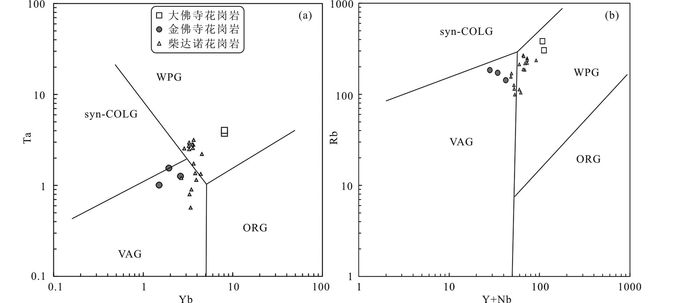
|
图 10 大佛寺、金佛寺花岗岩的Yb-Ta (a)和Y+Nb-Rb (b)构造环境判别图(据Pearce et al., 1984) ORG:洋脊花岗岩;syn-COLG:同碰撞花岗岩;VAG:火山弧花岗岩;WPG:板内花岗岩 Fig. 10 Yb-Ta (a) and Y+Nb-Rb (b) diagrams indicating possible tectonic settings for the Dafosi and Jinfosi granites (after Pearce et al., 1984) ORG: ocean ridge granites; syn-COLG: syn-collision granites; VAG: volcanic arc granites; WPG: within plate granites |
A型花岗岩形成的温度高、深度浅的特征,指示地壳拉张减薄的构造环境(韩宝福, 2007; 吴福元等, 2007; 张旗等, 2012),本文首次报道走廊过渡带大佛寺岩体的形成时代和地球化学特征,查明该岩体为A型花岗岩,指示北祁连造山带及邻区在志留纪中期可能已经进入碰撞后拉伸阶段。这一判断也得到地质证据的有力支持:在阿拉善地块的南缘,龙首山西井镁铁质侵入岩、走廊过渡带大佛寺岩体的形成时代分别为421.0±9.0Ma(段俊等, 2015)和426.1±2.8Ma,而北祁连造山带的毛藏寺岩体、金佛寺岩体的形成时代分别为424±4Ma(熊子良等, 2012)和424.0±1.6Ma;上述隶属于不同构造单元的岩体的时代相同,应具有共同的构造背景,表明~425Ma之前北祁连洋盆闭合、板块碰撞已经完成。
走廊过渡带被认为是阿拉善地块的一部分(冯益民和吴汉泉, 1992; 宋述光, 1997; Zhang et al., 2016),但早期被划归到祁连山地槽带(李春昱等, 1975),带内缺乏前寒武纪地层,其深部地壳的属性尚不清楚。走廊过渡带的地质演化过程以及诸多花岗岩体的时代和岩石地球化学特征也有待查明。本文揭示河西走廊大佛寺A型花岗岩的源岩为泥质岩,主体为古老陆壳物质,有助于揭示走廊过渡带的深部地壳属性。
6 结论(1) 河西走廊大佛寺花岗岩为A型,锆石δ18O和εHf(t)值分别为7.8‰~8.6‰(平均8.24±0.13‰)和-4.8~-2.0,Hf同位素两阶段亏损地幔模式年龄1540~1717Ma,其源岩可能为泥质岩,岩浆温度达到~820℃以上。走廊南山北缘金佛寺花岗岩的锆石δ18O为7.4‰~9.7‰(平均8.03±0.36‰),εHf(t)在-0.5~+1.9之间,Hf同位素两阶段亏损地幔模式年龄为1289~1439Ma,其源岩可能包括杂砂岩和角闪岩,岩浆温度达到800~900℃。
(2) 大佛寺(426.1±2.8Ma)、金佛寺(424.0±1.6Ma)岩体分别属于阿拉善地块、北祁连造山带不同构造单元,其锆石U-Pb SIMS年龄基本一致,指示在~425Ma北祁连洋盆已经闭合,北祁连造山带及邻区进入到后碰撞拉伸阶段。
致谢 主量元素分析得到王红月、李月红、薛丁帅、李禾的指导,微量元素分析得到李文君、高炳宇的指导。锆石靶由马红霞制作,锆石阴极发光图像照相得到闰欣、杨赛红的帮助,锆石氧同位素分析和SIMS U-Pb定年得到凌潇潇、李娇、唐国强、李献华、刘宇的指导,锆石Hf同位素分析得到杨岳衡老师、张维骐和杨雷的帮助。王世峰、张华锋提出了宝贵的修改建议。在此一并表示衷心的感谢。| [] | Arndt NT, Goldstein SL. 1987. Use and abuse of crust-formation ages. Geology, 15(10): 893–895. DOI:10.1130/0091-7613(1987)15<893:UAAOCA>2.0.CO;2 |
| [] | Bau M. 1996. Controls on the fractionation of isovalent trace elements in magmatic and aqueous systems:Evidence from Y/Ho, Zr/Hf, and lanthanide tetrad effect. Contributions to Mineralogy and Petrology, 123(3): 323–333. DOI:10.1007/s004100050159 |
| [] | Blichert-Toft J, Albarède F. 1997. The Lu-Hf isotope geochemistry of chondrites and the evolution of the mantle-crust system. Earth and Planetary Science Letters, 148(1-2): 243–258. DOI:10.1016/S0012-821X(97)00040-X |
| [] | Bonin B. 2007. A-type granites and related rocks:Evolution of a concept, problems and prospects. Lithos, 97(1-2): 1–29. DOI:10.1016/j.lithos.2006.12.007 |
| [] | Broska I, Williams CT, Uher P, Konečný P, Leichmann J. 2004. The geochemistry of phosphorus in different granite suites of the Western Carpathians, Slovakia:The role of apatite and P-bearing feldspar. Chemical Geology, 205(1-2): 1–15. DOI:10.1016/j.chemgeo.2003.09.004 |
| [] | Chappell BW, White AJR. 1974. Two contrasting granite types. Pacific Geology, 8: 173–174. |
| [] | Chappell BW, White AJR. 1992. I-and S-type granites in the Lachlan Fold Belt. Transactions of the Royal Society of Edinburgh:Earth Sciences, 83(1-2): 1–26. DOI:10.1017/S0263593300007720 |
| [] | Chappell BW. 1999. Aluminium saturation in I-and S-type granites and the characterization of fractionated haplogranites. Lithos, 46(3): 535–551. DOI:10.1016/S0024-4937(98)00086-3 |
| [] | Chappell BW, White AJR. 2001. Two contrasting granite types:25 years later. Australian Journal of Earth Sciences, 48(4): 489–499. DOI:10.1046/j.1440-0952.2001.00882.x |
| [] | Chen YX, Song SG, Niu YL, Wei CJ. 2014. Melting of continental crust during subduction initiation:A case study from the Chaidanuo peraluminous granite in the North Qilian suture zone. Geochimica et Cosmochimica Acta, 132: 311–336. DOI:10.1016/j.gca.2014.02.011 |
| [] | Cheng H, Lu TY, Cao DD. 2016. Coupled Lu-Hf and Sm-Nd geochronology constrains blueschist-facies metamorphism and closure timing of the Qilian Ocean in the North Qilian orogen. Gondwana Research, 34: 99–108. DOI:10.1016/j.gr.2016.03.008 |
| [] | Clemens JD, Holloway JR, White AJR. 1986. Origin of an A-type granite:Experimental constraints. American Mineralogist, 71(3-4): 317–324. |
| [] | Corfu F, Hanchar JM, Hoskin PWO, Kinny P. 2003. Atlas of zircon textures. Reviews in Mineralogy and Geochemistry, 53(1): 469–500. DOI:10.2113/0530469 |
| [] | Creaser RA, Price RC, Wormald RJ. 1991. A-type granites revisited:Assessment of a residual-source model. Geology, 19(2): 163–166. DOI:10.1130/0091-7613(1991)019<0163:ATGRAO>2.3.CO;2 |
| [] | Dang JH. 2011. Geochemical characteristics and tectonic implications of Jinfosi granite in theNorth Qilian. Gansu Geology, 20(2): 40–44. |
| [] | Duan J, Qian ZZ, Jiao JG, Lu H, Feng YQ. 2015. Genesis of Xijing intrusion from Longshoushan terrane and the tectonic significance. Journal of Jilin University (Earth Science Edition), 45(3): 832–846. |
| [] | Duc-Tin Q, Keppler H. 2015. Monazite and xenotime solubility in granitic melts and the origin of the lanthanide tetrad effect. Contributions to Mineralogy and Petrology, 169: 8. DOI:10.1007/s00410-014-1100-9 |
| [] | Eby GN. 1992. Chemical subdivision of the A-type granitoids:Petrogenetic and tectonic implications. Geology, 20(7): 641–644. DOI:10.1130/0091-7613(1992)020<0641:CSOTAT>2.3.CO;2 |
| [] | Feng YM, Wu HQ. 1992. Tectonic evolution of North Qilian Mountains and its neighbourhood since Paleozoic. Northwest Geoscience, 13(2): 61–74. |
| [] | Feng YM, He SP. 1995. Research for geology and geochemistry of several ophiolites in the North Qilian Mountains, China. Acta Petrologica Sinica, 11(Suppl.): 125–146. |
| [] | Ge XH, Liu JL. 1999. Formation and tectonic background of the northern Qilian orogenic belt. Earth Science Frontiers, 6(4): 223–230. |
| [] | Goldstein SL, O'Nions RK, Hamilton PJ. 1984. A Sm-Nd isotopic study of atmospheric dusts and particulates from major river systems. Earth and Planetary Science Letters, 70(2): 221–236. DOI:10.1016/0012-821X(84)90007-4 |
| [] | Griffin WL, Pearson NJ, Belousova E, Jackson SE, van Achterbergh E, O'Reilly SY, Shee SR. 2000. The Hf isotope composition of cratonic mantle:LAM-MC-ICPMS analysis of zircon megacrysts in kimberlites. Geochimica et Cosmochimica Acta, 64(1): 133–147. DOI:10.1016/S0016-7037(99)00343-9 |
| [] | Griffin WL, Wang X, Jackson SE, Pearson NJ, O'Reilly SY, Xu XS, Zhou XM. 2002. Zircon chemistry and magma mixing, SE China:In-situ analysis of Hf isotopes, Tonglu and Pingtan igneous complexes. Lithos, 61(3-4): 237–269. DOI:10.1016/S0024-4937(02)00082-8 |
| [] | Han BF. 2007. Diverse post-collisional granitoids and their tectonic setting discrimination. Earth Science Frontiers, 14(3): 64–72. |
| [] | Hayden LA, Watson EB. 2007. Rutile saturation in hydrous siliceous melts and its bearing on Ti-thermometry of quartz and zircon. Earth and Planetary Science Letters, 258(3-4): 561–568. DOI:10.1016/j.epsl.2007.04.020 |
| [] | Hoskin PWO, Schaltegger U. 2003. The composition of zircon and igneous and metamorphic petrogenesis. Reviews in Mineralogy and Geochemistry, 53(1): 27–62. DOI:10.2113/0530027 |
| [] | Huang CC, Jen CS, Jiang CF, Chang CM, Chang CK. 1974. Some new observations on the geotectonic characteristics of China. Acta Geologica Sinica, 48(1): 36–52. |
| [] | Huang H, Niu YL, Mo XX. 2017. Garnet effect on Nd-Hf isotope decoupling:Evidence from the Jinfosi batholith, Northern Tibetan Plateau. Lithos, 274-275: 31–38. DOI:10.1016/j.lithos.2016.12.025 |
| [] | Huang HQ, Li XH, Li WX, Li ZX. 2011. Formation of high δ18O fayalite-bearing A-type granite by high-temperature melting of granulitic metasedimentary rocks, Southern China. Geology, 39(10): 903–906. DOI:10.1130/G32080.1 |
| [] | Huang TK, Jen CS, Jiang CF, Chang CM, Xu ZQ. 1977. An outline of the tectonic characteristics of China. Acta Geologica Sinica, 51(2): 117–135. |
| [] | King PL, White AJR, Chappell BW, Allen CM. 1997. Characterization and origin of aluminous A-type granites from the Lachlan fold belt, southeastern Australia. Journal of Petrology, 38(3): 371–391. DOI:10.1093/petroj/38.3.371 |
| [] | Li CY. 1975. Tectonic evolutions of some mountain ranges in China, as tentatively interpreted on the concept of plate tectonics. Acta Geophysica Sinica, 18(1): 52–76. |
| [] | Li TD, Geng SF, Fan BX. 2006. Geological Map of Western China and Neighbourhood (Scale 1:2500000). Beijing: Geological Publishing House. |
| [] | Li XH, Liu Y, Li QL, Guo CH, Chamberlain KR. 2009. Precise determination of Phanerozoic zircon Pb/Pb age by multicollector SIMS without external standardization. Geochemistry, Geophysics, Geosystems, 10(4): Q04010. DOI:10.1029/2009GC002400 |
| [] | Li XH, Li WX, Wang XC, Li QL, Liu Y, Tang GQ. 2009. Role of mantle-derived magma in genesis of Early Yanshanian granites in the Nanling Range, South China:In situ zircon Hf-O isotopic constraints. Science in China (Series D), 52(9): 1262–1278. DOI:10.1007/s11430-009-0117-9 |
| [] | Li XH, Long WG, Li QL, Liu Y, Zheng YF, Yang YH, Chamberlain KR, Wan DF, Guo CH, Wang XC, Tao H. 2010. Penglai zircon megacrysts:A potential new working reference material for microbeam determination of Hf-O isotopes and U-Pb age. Geostandards and Geoanalytical Research, 34(2): 117–134. DOI:10.1111/j.1751-908X.2010.00036.x |
| [] | Li XH, Tang GQ, Gong B, Yang YH, Hou KJ, Hu ZC, Li QL, Liu Y, Li WX. 2013. Qinghu zircon:A working reference for microbeam analysis of U-Pb age and Hf and O isotopes. Chinese Science Bulletin, 58(36): 4647–4654. DOI:10.1007/s11434-013-5932-x |
| [] | Lin YH, Zhang LF, Ji JQ, Wang QJ, Song SG. 2010. 40Ar/39Ar isochron ages of lawsonite blueschists from Jiuquan in the northern Qilian Mountain, NW China, and their tectonic implications. Chinese Science Bulletin, 55(19): 2021–2027. DOI:10.1007/s11434-010-3239-8 |
| [] | Loiselle MC, Wones DR. 1979. Characteristics and origin of anorogenic granites. Geological Society of America Abstracts with Programs, 11: 468. |
| [] | Longstaffe FJ, Schwarcz HP. 1977. Sol18O16O of Archean clastic metasedimentary rocks:A petrogenetic indicator for Archean gneisses. Geochimica et Cosmochimica Acta,, 47(9): 1303–1312. |
| [] | Ludwig KR. 2009. soplot 4.1:A Geochronological Toolkit for Microsoft Excel. Berkeley Geochronology Center Special Publication, 4: 76. |
| [] | Magaritz M, Taylor Jr HP. 1976. Oxygen, hydrogen and carbon isotope studies of the Franciscan formation, Coast Ranges, California. Geochimica et Cosmochimica Acta, 40(2): 215–234. DOI:10.1016/0016-7037(76)90179-4 |
| [] | Maniar PD, Piccoli PM. 1989. Tectonic discrimination of granitoids. Geological Society of America Bulletin, 101(5): 635–643. DOI:10.1130/0016-7606(1989)101<0635:TDOG>2.3.CO;2 |
| [] | McLennan SM. 1994. Rare earth element geochemistry and the"tetrad" effect. Geochimica et Cosmochimica Acta, 58(9): 2025–2033. DOI:10.1016/0016-7037(94)90282-8 |
| [] | Meng FC, Zhang JX, Ker CM, Li JP. 2010. Constraints on the evolution of the North Qilian ocean basin:MOR-type and SSZ-type ophiolites from Dachadaban. Acta Petrologica et Mineralogica, 29(5): 453–466. |
| [] | Miller RG, O'Nions RK, Hamilton PJ, Welin E. 1986. Crustal residence ages of clastic sediments, orogeny and continental evolution. Chemical Geology, 57(1-2): 87–99. DOI:10.1016/0009-2541(86)90095-1 |
| [] | Nash WP, Crecraft HR. 1985. Partition coefficients for trace elements in silicic magmas. Geochimica et Cosmochimica Acta, 49(11): 2309–2322. DOI:10.1016/0016-7037(85)90231-5 |
| [] | Patiño Douce AE. 1997. Generation of metaluminous A-type granites by low-pressure melting of calc-alkaline granitoids. Geology, 25(8): 743–746. DOI:10.1130/0091-7613(1997)025<0743:GOMATG>2.3.CO;2 |
| [] | Patiño Douce AE. 1999. What do experiments tell us about the relative contributions of crust and mantle to the origin of granitic magmas? In:Castro A, Fernandez C and Vigneresse JL (eds. ). Understanding Granites:Integrating New and Classical Techniques. Geological Society, London, Special Publications, 168: 55–75. DOI:10.1144/GSL.SP.1999.168.01.05 |
| [] | Pearce JA, Harris NBW, Tindle AG. 1984. Trace element discrimination diagrams for the tectonic interpretation of granitic rocks. Journal of Petrology, 25(4): 956–983. DOI:10.1093/petrology/25.4.956 |
| [] | Pearce JA. 1996. Sources and settings of granitic rocks. Episodes, 19(4): 120–125. |
| [] | Rollinson HR. 1993. Using Geochemical Data:Evaluation, Presentation, Interpretation. New York: Longman Scientific & Technical: 1-352. |
| [] | Simon L, Lécuyer C. 2005. Continental recycling:The oxygen isotope point of view. Geochemistry, Geophysics, Geosystems, 6(8): Q08004. DOI:10.1029/2005GC000958 |
| [] | Sláma J, Košler J, Condon DJ, Crowley JL, Gerdes A, Hanchar JM, Horstwood MSA, Morris GA, Nasdala L, Norberg N, Schaltegger U, Schoene B, Tubrett MN, Whitehouse MJ. 2008. Plešovice zircon:A new natural reference material for U-Pb and Hf isotopic microanalysis. Chemical Geology, 249(1-2): 1–35. DOI:10.1016/j.chemgeo.2007.11.005 |
| [] | Song SG. 1997. Tectonic evolution of subductive complex belts in the north Qilian mountains. Advance in Earth Sciences, 12(4): 351–365. |
| [] | Song SG, Zhang LF, Niu YL, Song B, Zhang GB, Wang QJ. 2004. Zircon U-Pb SHRIMP ages of eclogites from the North Qilian Mountains in NW China and their tectonic implications. Chinese Science Bulletin, 49(8): 848–852. DOI:10.1007/BF02889759 |
| [] | Song SG, Niu YL, Zhang LF, Wei CJ, Liou JG, Su L. 2009. Tectonic evolution of Early Paleozoic HP metamorphic rocks in the North Qilian Mountains, NW China:New perspectives. Journal of Asian Earth Sciences, 35(3-4): 334–353. DOI:10.1016/j.jseaes.2008.11.005 |
| [] | Song SG, Niu YL, Su L, Xia XH. 2013. Tectonics of the North Qilian orogen, NW China. Gondwana Research, 23(4): 1378–1401. DOI:10.1016/j.gr.2012.02.004 |
| [] | Stacey JS, Kramers JD. 1975. Approximation of terrestrial lead isotope evolution by a two-stage model. Earth and Planetary Science Letters, 26(2): 207–221. DOI:10.1016/0012-821X(75)90088-6 |
| [] | Steinitz A, Katzir Y, Valley JW, Be'eri-Shlevin Y, Spicuzza MJ. 2009. The origin, cooling and alteration of A-type granites in southern Israel (northernmost Arabian-Nubian shield):A multi-mineral oxygen isotope study. Geological Magazine, 146(2): 276–290. DOI:10.1017/S0016756808005566 |
| [] | Stern RA, Hanson GN, Shirey SB. 1989. Petrogenesis of mantle-derived, LILE-enriched Archean monzodiorites and trachyandesites (sanukitoids) in southwestern Superior Province. Canadian Journal of Earth Sciences, 26(9): 1688–1712. DOI:10.1139/e89-145 |
| [] | Sun SS, McDonough WF. 1989. Chemical and isotopic systematics of oceanic basalts:Implications for mantle composition and processes. In:Saunders AD and Norry MJ (eds.). Magmatism in the Ocean Basins. Geological Society, London, Special Publication, 42(1): 313–345. DOI:10.1144/GSL.SP.1989.042.01.19 |
| [] | Sun XL, Liu XH, Liu JF and Sun BN. 2013. The age and origin of the Jinfosi biotite granite, North Qilian, NW China:Evidence from U-Pb zircon age data, geochemistry, and Nd-Sr-Pb isotopes. In:Zhang YJ, Xu QJ and Sun MJ (eds.). Sustainable Development of Natural Resources, Pts 1-3. Advanced Materials Research, 3-18 |
| [] | Sylvester PJ. 1998. Post-collisional strongly peraluminous granites. Lithos, 45(1-4): 29–44. DOI:10.1016/S0024-4937(98)00024-3 |
| [] | Tatsumi Y, Ishizaka K. 1981. Existence of andesitic primary magma:An example from southwest Japan. Earth and Planetary Science Letters, 53(1): 124–130. DOI:10.1016/0012-821X(81)90033-9 |
| [] | Tseng CY, Yang HJ, Yang HY, Liu DY, Tsai CL, Wu HQ, Zuo GC. 2007. The Dongcaohe ophiolite from the North Qilian Mountains:A fossil oceanic crust of the Paleo-Qilian Ocean. Chinese Science Bulletin, 52(17): 2390–2401. DOI:10.1007/s11434-007-0300-3 |
| [] | Valley JW, Lackey JS, Cavosie AJ, Clechenko CC, Spicuzza MJ, Basei MAS, Bindeman IN, Ferreira VP, Sial AN, King EM, Peck WH, Sinha AK, Wei CS. 2005. 4.4 billion years of crustal maturation:Oxygen isotope ratios of magmatic zircon. Contributions to Mineralogy and Petrology, 150(6): 561–580. DOI:10.1007/s00410-005-0025-8 |
| [] | Wang Q, Liu XY. 1976. Paleo-oceanic crust of the Chilienshan region, western China and its tectonic significance. Scientia Geologica Sinica, 11(1): 42–55. |
| [] | Watson EB, Harrison TM. 1983. Zircon saturation revisited:Temperature and composition effects in a variety of crustal magma types. Earth and Planetary Science Letters, 64(2): 295–304. DOI:10.1016/0012-821X(83)90211-X |
| [] | Whalen JB, Currie KL, Chappell BW. 1987. A-type granites:Geochemical characteristics, discrimination and petrogenesis. Contributions to Mineralogy and Petrology, 95(4): 407–419. DOI:10.1007/BF00402202 |
| [] | Whalen JB, Jenner GA, Longstaffe FJ, Robert F, Gariépy C. 1996. Geochemical and isotopic (O, Nd, Pb and Sr) constraints on A-type granite petrogenesis based on the Topsails igneous suite, Newfoundland Appalachians. Journal of Petrology, 37(6): 1463–1489. DOI:10.1093/petrology/37.6.1463 |
| [] | Woodhead JD, Hergt JM. 2005. A preliminary appraisal of seven natural zircon reference materials for in situ Hf isotope determination. Geostandards and Geoanalytical Research, 29(2): 183–195. DOI:10.1111/ggr.2005.29.issue-2 |
| [] | Wu CL, Yao SZ, Yang JS, Zeng LS, Chen SY, Li HB, Qi XX, Wooden JL, Mazdab FK. 2006. Double subduction of the Early Paleozoic North Qilian oceanic plate:Evidence from granites in the central segment of North Qilian, NW China. Geology in China, 33(6): 1197–1208. |
| [] | Wu CL, Xu XY, Gao QM, Li XM, Lei M, Gao YH, Frost RB, Wooden JL. 2010. Early Palaezoic grranitoid magmatism and tectonic evolution in North Qilian, NW China. Acta Petrologica Sinica, 26(4): 1027–1044. |
| [] | Wu FY, Sun DY, Li HM, Jahn BM, Wilde S. 2002. A-type granites in northeastern China:Age and geochemical constraints on their petrogenesis. Chemical Geology, 187(1-2): 143–173. DOI:10.1016/S0009-2541(02)00018-9 |
| [] | Wu FY, Yang YH, Xie LW, Yang JH, Xu P. 2006. Hf isotopic compositions of the standard zircons and baddeleyites used in U-Pb geochronology. Chemical Geology, 234(1-2): 105–126. DOI:10.1016/j.chemgeo.2006.05.003 |
| [] | Wu FY, Li XY, Yang JH, Zheng YF. 2007. Discussions on the petrogenesis of granites. Acta Petrologica Sinica, 23(6): 1217–1238. |
| [] | Wu HQ. 1980. The glaucophane-schists of eastern Qinling and northernQilian Mountain in China. Acta Geologica Sinica, 54(3): 195–207, 251. |
| [] | Wu HQ. 1982. Petrology and mineralogy of high-pressure metamorphic zones in northern Qilian Mountain, China. Bull. Xi'an Inst. Geol. Min. Res. Chinese Acad. Geol. Sci.(4): 5–21. |
| [] | Wu P, Li XM, Xu XY, Yu JY, Sun JM, Tang Z, Wang GQ. 2012. LA-ICP-MS zircon U-Pb dating and geochemical characteristics of Donggou ophiolites in Zamashi area of northern Qilian Mountain. Geological Bulletin of China, 31(6): 896–906. |
| [] | Xia LQ, Xia ZC, Peng LG, Ren YX, Yang JH, Zhang C, Li ZP, Wang XA. 1991. Determination of magmatic nature of Ordovician island arc volcanic series in the Shihuigou area in the northern Qilian Mountains. Acta Petrologica et Mineralogica, 10(1): 1–10. |
| [] | Xia LQ, Xia ZC, Xu XY. 1995. Dynamics of tectono-volcano-magmatic evolution from North Qilian Mountains, China. Northwest Geoscience, 16(1): 1–28. |
| [] | Xia XH, Song SG, Niu YL. 2012. Tholeiite-boninite terrane in the North Qilian suture zone:Implications for subduction initiation and back-arc basin development. Chemical Geology, 328: 259–277. DOI:10.1016/j.chemgeo.2011.12.001 |
| [] | Xia XH, Sun N, Song SG, Xiao XC. 2012. Age and tectonic setting of the Aoyougou-Erzhihaladaban ophiolite in the western North Qilian Mountains, NW China. Acta Scientiarum Naturalium Universitatis Pekinensis, 48(5): 757–769. |
| [] | Xiang ZQ, Li SN, Li HK, Li HM, Song B, Zheng JK. 2007. SHRIMP U-Pb zircon age of gabbro in Aoyougou in the western segment of the North Qilian Mountains, China and its geological implications. Geological Bulletin of China, 26(12): 1686–1691. |
| [] | Xiao XC, Chen GM, Zhu ZZ. 1978. A preliminary study on the tectonics of ancient ophiolites in the Qilian Mountain, northwest China. Acta Geologica Sinica, 52(4): 281–296. |
| [] | Xiong ZL, Zhang HF, Zhang J. 2012. Petrogenesis and tectonic implications of the Maozangsi and Huangyanghe granitic intrusions in Lenglongling area, the eastern part of North Qilian Mountains, NW China. Earth Science Frontiers, 19(3): 214–227. |
| [] | Xu P, Wu FY, Xie LW, Yang YH. 2004. Hf isotopic compositions of the standard zircons for U-Pb dating. Chinese Science Bulletin, 49(15): 1642–1648. DOI:10.1007/BF03184136 |
| [] | Xu X, Song SG, Allen MB, Ernst RE, Niu YL, Su L. 2016. An 850~820Ma LIP dismembered during breakup of the Rodinia supercontinent and destroyed by Early Paleozoic continental subduction in the northern Tibetan Plateau, NW China. Precambrian Research, 282: 52–73. DOI:10.1016/j.precamres.2016.07.007 |
| [] | Xu ZQ, Xu HF, Zhang JX, Li HB, Zhu ZZ, Qu JC, Chen DZ, Chen JL, Yang KC. 1994. The Zhoulangnanshan Caledonian subductive complex in the northern Qilian Mountains and its dynamics. Acta Geologica Sinica, 68(1): 1–15. |
| [] | Yan Z, Xiao WJ, Windley BF, Wang ZQ, Li JL. 2010. Silurian clastic sediments in the North Qilian Shan, NW China:Chemical and isotopic constraints on their forearc provenance with implications for the Paleozoic evolution of the Tibetan Plateau. Sedimentary Geology, 231(3-4): 98–114. DOI:10.1016/j.sedgeo.2010.09.001 |
| [] | Yang JH, Chung SL, Zhai MG, Zhou XH. 2004. Geochemical and Sr-Nd-Pb isotopic compositions of mafic dikes from the Jiaodong Peninsula, China:Evidence for vein-plus-peridotite melting in the lithospheric mantle. Lithos, 73(3-4): 145–160. DOI:10.1016/j.lithos.2003.12.003 |
| [] | Yang YN, Li QL, Liu Y, Tang GQ, Ling XX, Li XH. 2014. Zircon U-Pb dating by secondary ion mass spectrometry. Earth Science Frontiers, 21(2): 81–92. |
| [] | Yu XX, Zhang JX. 2016. Zircon U-Pb geochronology and Hf-isotope compositions of the eclogitic metasedimentary rocks in Xiangzigou, North Qilian Mountains and their geological implications. Acta Petrologica Sinica, 32(5): 1437–1451. |
| [] | Zhang BH, Zhang J, Zhang YP, Zhao H, Wang YN, Nie FJ. 2016. Tectonic affinity of the Alxa Block, Northwest China:Constrained by detrital zircon U-Pb ages from the Early Paleozoic strata on its southern and eastern margins. Sedimentary Geology, 339: 289–303. DOI:10.1016/j.sedgeo.2016.02.017 |
| [] | Zhang JX, Xu ZQ, Li HB, Xu HF. 1997. The transition of orogenic mechanism from compression to extension in northern Qilian orogenic belt. Journal of Changchun University of Earth Sciences, 27(3): 277–283. |
| [] | Zhang JX, Xu ZQ, Xu HF, Li HB. 1998. Framework of north Qilian Caledonian subduction-accretionary wedge and its deformation dynamics. Scientia Geologica Sinica, 33(3): 290–299. |
| [] | Zhang JX, Meng FC, Wan YS. 2007. A cold Early Palaeozoic subduction zone in the North Qilian Mountains, NW China:Petrological and U-Pb geochronological constraints. Journal of Metamorphic Geology, 25(3): 285–304. DOI:10.1111/jmg.2007.25.issue-3 |
| [] | Zhang JX, Yu SY, Mattinson CG. 2017. Early Paleozoic polyphase metamorphism in northern Tibet, China. Gondwana Research, 41: 267–289. DOI:10.1016/j.gr.2015.11.009 |
| [] | Zhang L, Chen RX, Zheng YF, Hu ZC, Yang YH, Xu LJ. 2015. Geochemical constraints on the protoliths of eclogites and blueschists from North Qilian, Northern Tibet. Chemical Geology, 421: 26–43. |
| [] | Zhang Q, Sun XM, Zhou DJ, Qian Q, Chen Y, Wang YM, Jia XQ, Han S. 1997. The characteristics of North Qilian ophiolites, forming settings and their tectonic significance. Advance in Earth Sciences, 12(4): 366–393. |
| [] | Zhang Q, Yu C, Zhou DJ, Qian Q, Jia XQ, Han S. 1998. Geochemical characteristics and genesis of Dachadaban ophiolite in North Qilian area. Science in China (Series D), 41(3): 277–281. DOI:10.1007/BF02973116 |
| [] | Zhang Q, Ran H, Li CD. 2012. A-type granite:What is the essence?. Acta Petrologica et Mineralogica, 31(4): 621–626. |
| [] | Zhao ZH, Xiong XL, Han XD, Wang YX, Wang Q, Bao ZW, Jahn BM. 2002. Controls on the REE tetrad effect in granites:Evidence from the Qianlishan and Baerzhe granites, China. Geochemical Journal, 36(6): 527–543. DOI:10.2343/geochemj.36.527 |
| [] | Zuo GC, Liu JC. 1987. The evolution of tectonic of Early Paleozoic in North Qilian range, China. Scientia Geologica Sinica, 22(1): 14–24. |
| [] | 党金花. 2011. 北祁连金佛寺岩体地球化学特征及构造意义. 甘肃地质, 20(2): 40–44. |
| [] | 段俊, 钱壮志, 焦建刚, 鲁浩, 冯延清. 2015. 甘肃龙首山岩带西井镁铁质岩体成因及其构造意义. 吉林大学学报(地球科学版), 45(5): 832–846. |
| [] | 冯益民, 吴汉泉. 1992. 北祁连山及其邻区古生代以来的大地构造演化初探. 西北地质科学, 13(2): 61–74. |
| [] | 冯益民, 何世平. 1995. 北祁连蛇绿岩的地质地球化学研究. 岩石学报, 11(增刊): 124–146. |
| [] | 葛肖虹, 刘俊来. 1999. 北祁连造山带的形成与背景. 地学前缘, 6(4): 223–230. |
| [] | 韩宝福. 2007. 后碰撞花岗岩类的多样性及其构造环境判别的复杂性. 地学前缘, 14(3): 64–72. |
| [] | 黄汲清, 任纪舜, 姜春发, 张之孟, 张正坤. 1974. 对中国大地构造若干特点的新认识. 地质学报, 48(1): 36–52. |
| [] | 黄汲清, 任纪舜, 姜春发, 张之孟, 许志琴. 1977. 中国大地构造基本轮廓. 地质学报, 51(2): 117–135. |
| [] | 李春昱. 1975. 用板块构造学说对中国部分地区构造发展的初步分析. 地球物理学报, 18(1): 52–76. |
| [] | 李廷栋, 耿树方, 范本贤. 2006. 中国西部及邻区地质图(1:250万). 北京: 地质出版社(请核对年份). |
| [] | 李献华, 李武显, 王选策, 李秋立, 刘宇, 唐国强. 2009. 幔源岩浆在南岭燕山早期花岗岩形成中的作用:锆石原位Hf-O同位素制约. 中国科学(D辑), 39(7): 872–887. |
| [] | 林宜慧, 张立飞, 季建清, 王乾杰, 宋述光. 2010. 北祁连山九个泉硬柱石蓝片岩40Ar-39Ar年龄及其地质意义. 科学通报, 55(17): 1710–1716. |
| [] | 孟繁聪, 张建新, 郭春满, 李金平. 2010. 大岔大坂MOR型和SSZ型蛇绿岩对北祁连洋演化的制约. 岩石矿物学杂志, 29(5): 453–466. |
| [] | 宋述光. 1997. 北祁连山俯冲杂岩带的构造演化. 地球科学进展, 12(4): 351–365. |
| [] | 宋述光, 张立飞, NiuYL, 宋彪, 张贵宾, 王乾杰. 2004. 北祁连山榴辉岩锆石SHRIMP定年及其构造意义. 科学通报, 49(6): 592–595. |
| [] | 王荃, 刘雪亚. 1976. 我国西部祁连山区的古海洋地壳及其大地构造意义. 地质科学, 11(1): 42–55. |
| [] | 吴才来, 姚尚志, 杨经绥, 曾令森, 陈松永, 李海兵, 戚学祥, WoodenJL, MazdabFK. 2006. 北祁连洋早古生代双向俯冲的花岗岩证据. 中国地质, 33(6): 1197–1208. |
| [] | 吴才来, 徐学义, 高前明, 李向民, 雷敏, 郜源红, FrostRB, WoodenJL. 2010. 北祁连早古生代花岗质岩浆作用及构造演化. 岩石学报, 26(4): 1027–1044. |
| [] | 吴福元, 李献华, 杨进辉, 郑永飞. 2007. 花岗岩成因研究的若干问题. 岩石学报, 23(6): 1217–1238. |
| [] | 吴汉泉. 1980. 东秦岭和北祁连山的蓝闪片岩. 地质学报, 54(3): 195–207, 251. |
| [] | 吴汉泉. 1982. 北祁连山高压变质带的岩石学和矿物学. 中国地质科学院西安地质矿产研究所所刊(4): 5–21. |
| [] | 武鹏, 李向民, 徐学义, 余吉远, 孙吉明, 唐卓, 王国强. 2012. 北祁连山扎麻什地区东沟蛇绿岩LA-ICP-MS锆石U-Pb测年及其地球化学特征. 地质通报, 31(6): 896–906. |
| [] | 夏林圻, 夏祖春, 彭礼贵, 任有祥, 杨静华, 张诚, 李智佩, 王兴安. 1991. 北祁连山石灰沟奥陶纪岛弧火山岩系岩浆性质的确定. 岩石矿物学杂志, 10(1): 1–10. |
| [] | 夏林圻, 夏祖春, 徐学义. 1995. 北祁连山构造-火山岩浆演化动力学. 西北地质科学, 16(1): 1–28. |
| [] | 夏小洪, 孙楠, 宋述光, 肖序常. 2012. 北祁连西段熬油沟-二只哈拉达坂蛇绿岩的形成环境和时代. 北京大学学报(自然科学版), 48(5): 757–769. |
| [] | 相振群, 陆松年, 李怀坤, 李惠民, 宋彪, 郑健康. 2007. 北祁连西段熬油沟辉长岩的锆石SHRIMP U-Pb年龄及地质意义. 地质通报, 26(12): 1686–1691. DOI:10.3969/j.issn.1671-2552.2007.12.023 |
| [] | 肖序常, 陈国铭, 朱志直. 1978. 祁连山古蛇绿岩带的地质构造意义. 地质学报, 52(4): 281–296. |
| [] | 熊子良, 张宏飞, 张杰. 2012. 北祁连东段冷龙岭地区毛藏寺岩体和黄羊河岩体的岩石成因及其构造意义. 地学前缘, 19(3): 214–227. |
| [] | 徐平, 吴福元, 谢烈文, 杨岳衡. 2004. U-Pb同位素定年标准锆石的Hf同位素. 科学通报, 49(14): 1403–1410. DOI:10.3321/j.issn:0023-074X.2004.14.012 |
| [] | 许志琴, 徐惠芬, 张建新, 李海兵, 朱志直, 曲景川, 陈代璋, 陈金禄, 杨开春. 1994. 北祁连走廊南山加里东俯冲杂岩增生地体及其动力学. 地质学报, 68(1): 1–15. |
| [] | 杨亚楠, 李秋立, 刘宇, 唐国强, 凌潇潇, 李献华. 2014. 离子探针锆石U-Pb定年. 地学前缘, 21(2): 81–92. |
| [] | 喻星星, 张建新. 2016. 北祁连香子沟榴辉岩相变沉积岩的锆石U-Pb年代学、Hf同位素特征及其地质意义. 岩石学报, 32(5): 1437–1451. |
| [] | 曾建元, 杨怀仁, 杨宏仪, 刘敦一, 蔡金郎, 吴汉泉, 左国朝. 2007. 北祁连东草河蛇绿岩:一个早古生代的洋壳残片. 科学通报, 52(7): 825–835. |
| [] | 张建新, 许志琴, 李海兵, 徐惠芬. 1997. 北祁连加里东造山带从挤压到伸展造山机制的转换. 长春地质学院学报, 27(3): 277–283. |
| [] | 张建新, 许志琴, 李海兵, 徐惠芬. 1998. 北祁连加里东期俯冲-增生楔结构及动力学. 地质科学, 33(3): 290–299. |
| [] | 张旗, 孙晓猛, 周德进, 钱青, 陈雨, 王岳明, 贾秀琴, 韩松. 1997. 北祁连蛇绿岩的特征、形成环境及其构造意义. 地球科学进展, 12(4): 366–393. |
| [] | 张旗, YuC, 周德进, 钱青, 贾秀琴, 韩松. 1998. 北祁连大岔大坂蛇绿岩的地球化学特征及其成因. 中国科学(D辑), 28(1): 30–34. |
| [] | 张旗, 冉皞, 李承东. 2012. A型花岗岩的实质是什么?. 岩石矿物学杂志, 31(4): 621–626. |
| [] | 左国朝, 刘寄陈. 1987. 北祁连早古生代大地构造演化. 地质科学, 22(1): 14–24. |
 2017, Vol. 33
2017, Vol. 33









